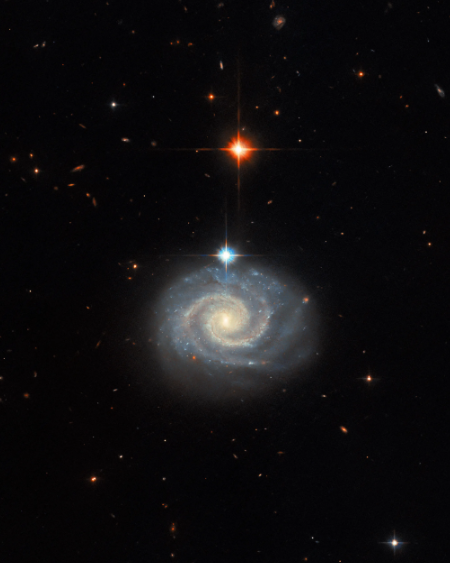NASA's Hubble Space Telescope has captured a mesmerizing image featuring the spiral galaxy MCG-01-24-014, located approximately 275 million light-years away from Earth.
This spiral galaxy stands out not only for its well-defined structure but also for its remarkably energetic core, designated as an active galactic nucleus (AGN), categorizing it as a Type-2 Seyfert galaxy.

Forbidden Emission Lines
Seyfert galaxies, a common subclass of AGNs along with quasars, exhibit distinctive characteristics in their spectral patterns. MCG-01-24-014, as a Type-2 Seyfert galaxy, is characterized by specific 'forbidden' emission lines in its spectrum.
The central region of Seyfert galaxies, where the AGN is located, is much brighter than the rest of the galaxy. The energy output from the AGN is believed to result from the accretion of mass onto a supermassive black hole at the galaxy's center.
As material falls into the black hole, it releases tremendous energy, producing the observed radiation. NASA noted that understanding the significance of these emission lines requires delving into the principles of quantum physics, where electrons orbiting the nuclei of atoms and molecules can only exist at specific energy levels.
Consequently, the absorption and emission of light occur at corresponding wavelengths determined by these energy levels. The term "forbidden" emission lines originates from the laboratory-based rules of quantum physics formulated on Earth.
Under these conditions, certain transitions of electrons are deemed so improbable that they are effectively disregarded. However, these assumptions are challenged when applied to the complex and energetic environment of a galactic core in space.
The "forbidden" light observed in MCG-01-24-014 results from quantum processes that defy traditional expectations. In the unique conditions of a galactic core, where energies are extreme and conventional quantum rules may not hold, the "forbidden" emission lines become visible to instruments like the Hubble Space Telescope.
Read Also : NASA Hubble Discovers Saturn's Ring System Heats Planet's Atmosphere-A Never-Before-Seen Phenomenon!
Challenging Quantum Physics
This phenomenon challenges our understanding of quantum physics in extraterrestrial environments, providing astronomers with valuable insights into the complexities of galactic dynamics.
While Seyfert galaxies are relatively nearby and their central AGNs do not overpower their hosts, the distant counterparts, known as quasars, exhibit extraordinary luminosities that outshine their entire galaxies.
This intricate dance of light and energy in galaxies adds a layer of complexity to our exploration of the cosmos, reminding us that the rules governing the universe may not always align with our Earth-bound expectations.
The Hubble Space Telescope continues to be an invaluable tool for astronomers, capturing stunning images that deepen our understanding of the vast celestial landscapes.
Related Article : NASA's Hubble Space Telescope Captures 'Butterfly Nebula' In Stunning Motion | Fun Facts About This Beautiful Space Butterfly

ⓒ 2025 TECHTIMES.com All rights reserved. Do not reproduce without permission.




